Over the past few years I have become increasingly interested in environmental conservation education and its role within museums.
Working for the Learning and Programmes department of National Museums Scotland I have been fortunate enough to work on a variety of projects with this at their core. One such example was the new teacher-led handling box ‘Animals – Ecosystems, Interdependence and the Environment’, which I blogged about previously.
Projects like these have allowed me to work closer with other departments, in particular Natural Sciences. I decided to request an ‘Across the Floor’ day – a National Museums Scotland scheme that allows staff the opportunity to spend a day in another department and see how they work. I was off to the Collection Centre in Granton to for a day in the life of a Natural Sciences team member.
Working with Learning and Programmes, I am used to trying to make a variety of topics accessible to young children, and one of the many ways we do this is to relate things to the senses – so that’s exactly what I’m going to do.
Smell – “apologies, that’s just the orca”
It is impossible to recount a day with Natural Sciences without mentioning the preparatory area. This is the part of the Collection Store where animal specimens are prepared for research and display. In many museums it is where the taxidermist would work; at National Museums Scotland we have a team of preparators. There are animals of various sizes, species, ages and preparedness everywhere but the first thing you notice is the smell. The worst offender was an orca being prepared for research. It had washed ashore and its bones were destined to help us learn more about the species and the health of Scottish seas. It was a smell I will never forget.
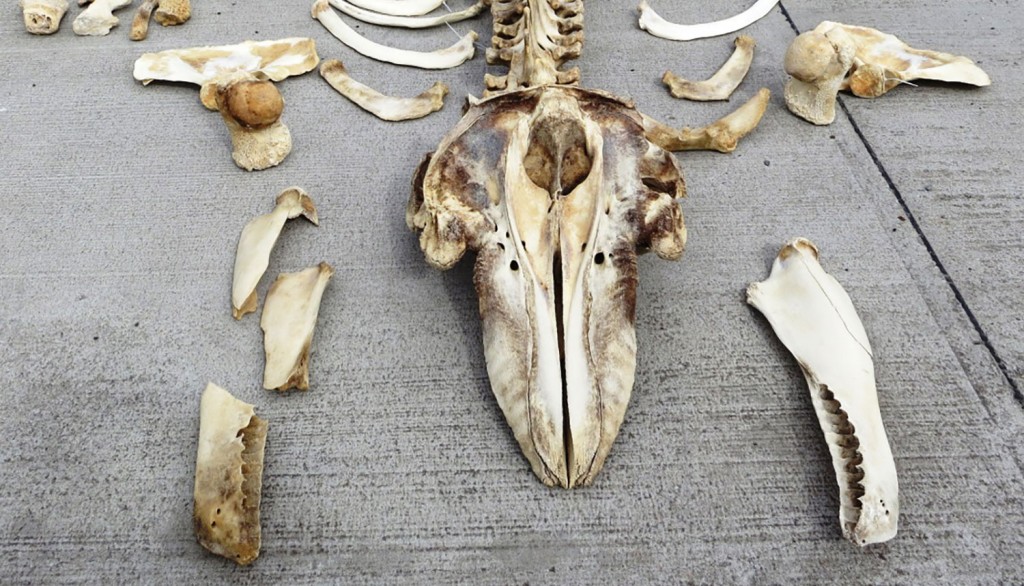
Touch – “we don’t want to get stuck to the freezer”
After seeing where animals were prepared for research it was time to get stuck in and work with some samples. The morning’s task was to take samples of frozen cotton-top tamarin flesh to send to Denmark. Once there, the samples will have DNA extracted and will be used to study the variety in genetics of captive cotton-top tamarins and how they have descended from once wild-living ones.
Real live conservation research in action, the conservation educator in me was thrilled – but my hands were a bit chilly. The specimens were, understandably, stored in a freezer to preserve them and ideally would not thaw out during our sample extraction. Wearing thick gloves to protect us when opening and closing the freezer and then latex gloves to protect the samples from contamination. Principle Curator of Vertebrate Biology Andrew Kitchener and myself began to prepare the packages for Copenhagen. Having never studied biology I had never used a scalpel before, but my cold hands soon got used to it and before long this section of the morning was complete.
Stage Two of the tamarin-focused part of my day was labelling the prepared tamarin skins for storage and future use. Whist labelling objects might not sound overly exciting, it is incredibly important. Labels allow curators and researchers quick access to information such as the zoo the animal came from, where it was born (if different to its last zoo), the species, the sex and the date of death (and birth if known). Without this information, these skins would be soft to touch and interesting to look at but would be of very limited scientific use. Labelling them gave me a unique opportunity to look at them each closely and feel the fur between my fingers of animals who continue to contribute to learning even after their deaths.
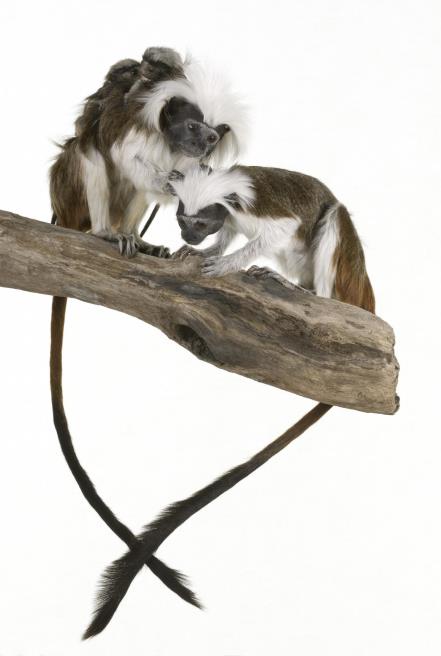
Hearing – “it’s just so peaceful”
Working with Learning and Programmes, a large part of my standard day is spent with children of all ages, and more often than not these are children who are excited to be at the museum. Part of the role of a Learning Enabler is to staff our interactive galleries which contain simple musical instruments for visitors to play with. In short, my job is usually pretty loud.
Entering Natural Sciences, however, it was another world: there was silence and it was golden. Each of the rooms we used were in the purpose-built Building 17 with long rows of storage shelving and workbenches. Because each room is used for storage of a specific animal group or research purpose there were rarely more than two or three of us in at a time. The result was a level of calm and peaceful silence that was quite a shock to the Learning and Programmes ear.
The thoughtful peace and quiet continued in the afternoon as I made my way across to the entomology team and their facilities.
Taste – “that’s the bees just going in the oven”
I know what you’re thinking – “what did she taste?!”. It is ok, I did not taste any of the Natural Science collections, although some smells were so strong it might have felt like it.
I spent the afternoon working with Assistant Curator of Entomology Ashleigh Whiffin preparing bumblebee specimens for the collection and future research. This involves very delicate use of forceps and pins to secure the insect to its plastazote base and ensure each of its six legs and tongue are visible. A bee’s tongue is, much like a bee, very small. Often it was also caught up with the front legs and so had to be very carefully unrolled and secured with a few pins either side while it dried out.
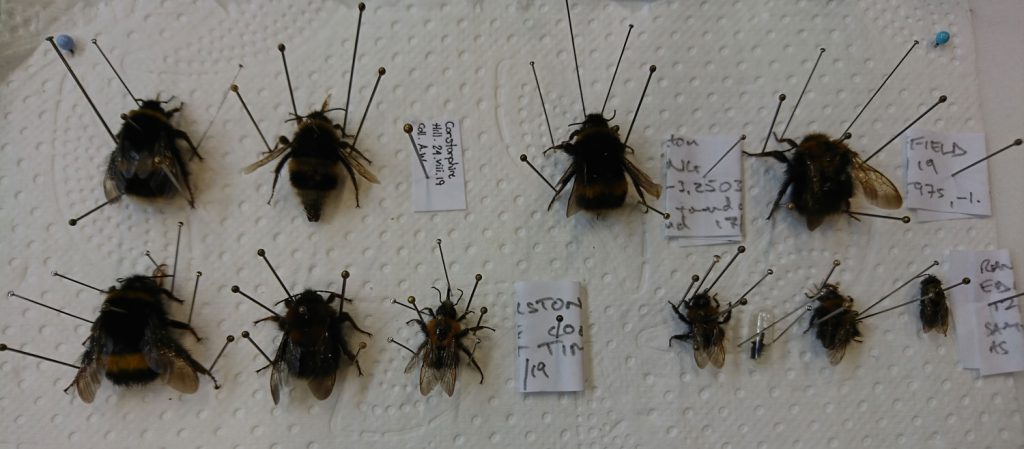
This process was fascinating. I love insects, always have, but had never really looked at a bee in such detail before. Pinning through the centre right of the body, gently placing each of its legs and tongue, using a tiny paintbrush to clean up its fur – I really got to see the marvel of evolution that is the humble bumblebee.
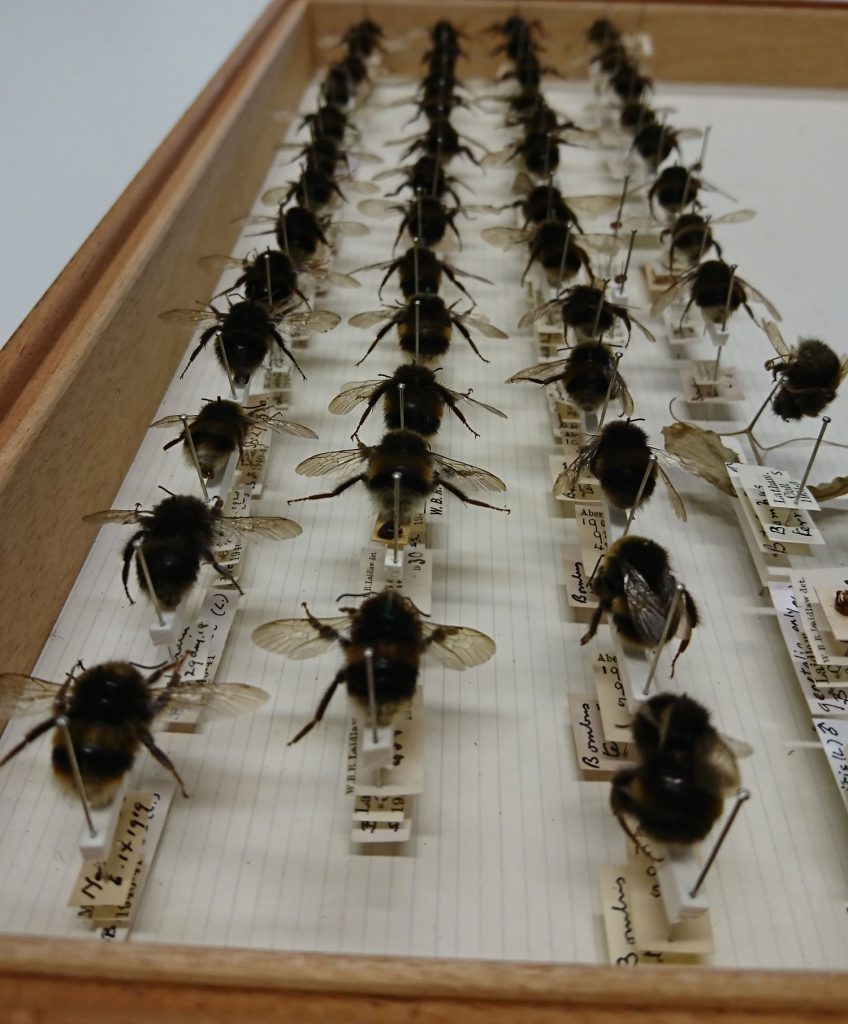
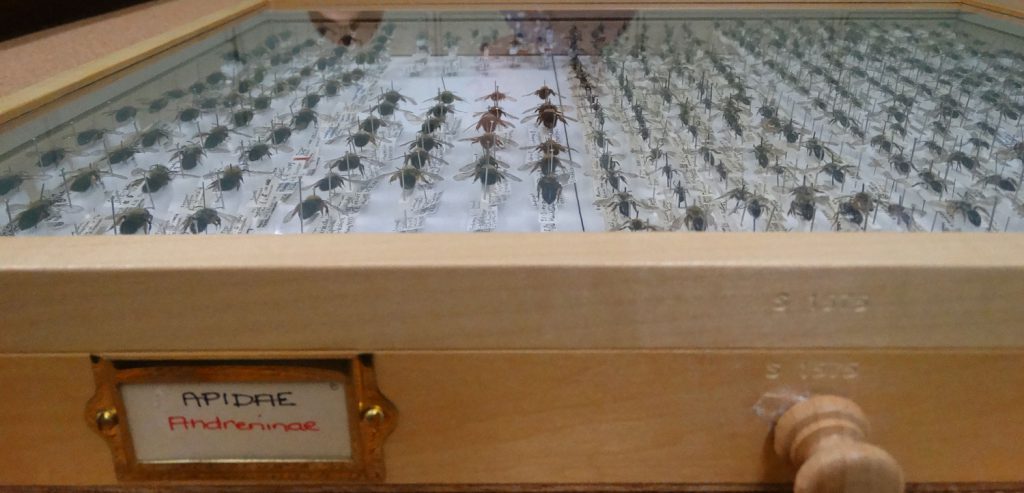
The bees went in Ashleigh’s mini oven to dry out, so later the supporting pins could be removed and the ever-vital data labels attached. Meanwhile, I moved on to my next task.
Sight – “that is ridiculously satisfying”
My final task of the day came back to labels. I had found labelling tamarins fiddly enough and was concerned at just how tiny the gall wasps before me were. Luckily, entomology has a tool for that. A pinning block might be one of my favourite new museum tools. A small silver brick with several holes it perfectly aligns each label at the right height allowing those using the collection to see the right information at a glance.
A private collection of gall wasps had been donated to the collection and my job was to add the new labels which would detail the donor and when they entered our collections. Within the hour, what had started as a box of wasps on its own was now fully labelled and added to the relevant specimen drawer of gall wasps in the collection. This drawer contains perfectly lined up specimens and was itself then added to beautifully organised cabinet of other drawers of specimens belonging to the same group.

Before I headed back to the reality of the National Museum of Scotland, Chambers Street, Ashleigh had one last labelling task for me. Over recent years as drawers have been added to and shuffled around their outer labels had been scored out, written over and updated several times. My final task for the day – standardise the outer labels for one block of drawers, filling two cabinets. This was a fairly quick but very satisfying task and by the time I left, that one shelving unit at least looked beautifully ordered and was an incredibly pleasing sight. This task will help researchers and other visitors to the collection who are interested in these wasps locate them quickly and with ease.
The ‘Across the Floor’ experience was fascinating and useful to my everyday practice in Learning and Programmes and I would like to thank Andrew Kitchener and Ashleigh Whiffin for hosting me. Not only am I now better informed about our collections and the National Museum Collection Centre’s role in collections care and research but I can finally answer the question every Learning Enabler is asked out in the galleries – “but where did the animals come from?”
